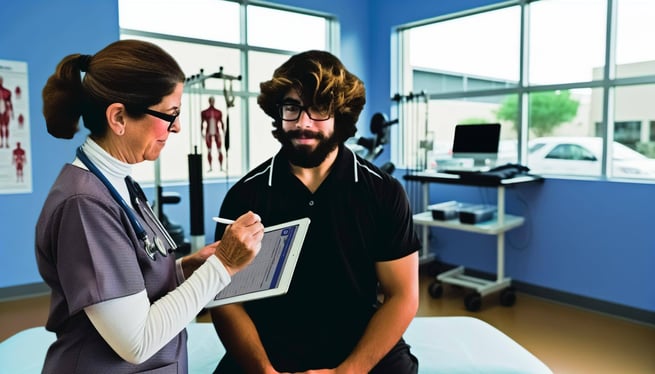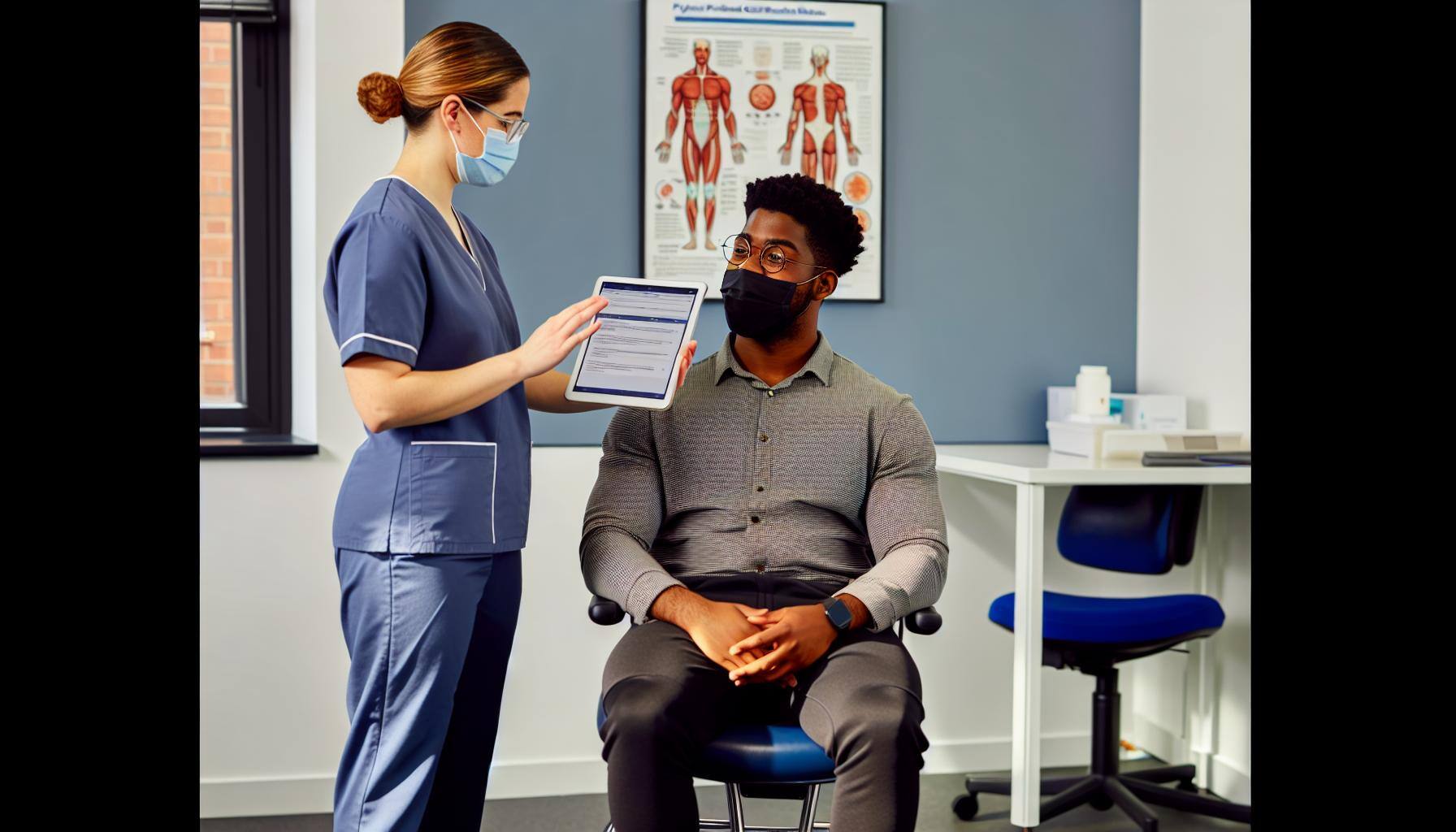August 5, 2024
Patient-Reported Outcome Measures for PT Professionals
The importance of delivering patient-centered care has never been more pronounced. One of the most effective tools in achieving this goal is the use of Patient-Reported Outcome Measures (PROMs). Understanding and implementing these tools can significantly enhance the quality of care provided, improve clinical outcomes, and ensure that the patient’s voice is at the center of all treatment decisions.
What Are Outcome Measures?
Outcome measures are tools used to assess a patient’s current health status. They provide a quantifiable way to track the effectiveness of treatments, the progression of conditions, and the overall impact of physical therapy on a patient's life. These measures can be broadly categorized into clinician-reported outcome measures (CROMs), which are observed and recorded by healthcare providers, and patient-reported outcome measures (PROMs), which are reported directly by the patient.
Patient-Reported Outcome Measures (PROMs)
The PROM medical abbreviation stands for Patient-Reported Outcome Measures. These are standardized tools that capture the patient’s perspective on their health condition and the impact of treatment. PROMs are essential because they provide insights that might not be apparent through clinical assessments alone. They allow patients to communicate their experiences, symptoms, and concerns, which are critical for personalized care.
Categories of PROMs:
-
Generic PROMs: These tools measure general health outcomes and are applicable to a broad range of conditions. An example is the EQ-5D, which evaluates a person’s overall health status across multiple dimensions, such as mobility, self-care, and anxiety.
-
Condition-Specific PROMs: These are tailored to particular diseases or conditions, focusing on specific symptoms and issues relevant to a defined patient population. For instance, the Shoulder Pain and Disability Index (SPADI) is used to assess pain and disability in patients with shoulder conditions.
-
Individualized PROMs: Less commonly used but increasingly recognized, these tools allow patients to identify and rate issues most relevant to their health and quality of life. Examples include the Patient Generated Index (PGI) and the Patient Specific Function Scale (PSFS).

Why Use PROMs in Physical Therapy?
Using PROMs in physical therapy provides multiple benefits that align with the goals of patient-centered care:
- Enhanced Decision-Making: PROMs provide critical information that helps in tailoring treatment plans to meet individual patient needs, ensuring that care decisions are data-driven and focused on outcomes that matter to the patient.
- Improved Patient Engagement: By actively involving patients in reporting their health status, PROMs encourage greater engagement in their own care, leading to better adherence to treatment plans.
- Objective Monitoring of Progress: PROMs offer a structured way to monitor treatment outcomes over time, helping both the therapist and the patient to see tangible progress or identify areas needing adjustment.
- Quality of Care Assessment: For practice owners, PROMs provide a means to assess and demonstrate the effectiveness of care provided, which can be useful for quality assurance and improving clinical protocols.
How to Implement PROMs Effectively
Integrating PROMs into your physical therapy practice involves several steps to ensure they are used effectively and efficiently.
1. Selecting the Right PROMs
When choosing a PROM, consider the following:
- Purpose: What do you want to measure? Whether it’s pain, disability, or quality of life, the PROM should align with your clinical goals.
- Relevance: The selected PROM should be appropriate for the patient’s specific condition or general health status.
- Psychometric Properties: Ensure the PROM is valid, reliable, and sensitive to changes in the patient’s condition. This means it should accurately measure what it intends to, produce consistent results, and detect changes over time.
Outcome measures examples include the Tampa Scale for Kinesiophobia, which assesses the fear of movement in patients with chronic pain, and the Pain Catastrophizing Scale, which measures exaggerated negative responses to pain.
2. Administering PROMs
PROMs can be administered in various formats, including paper-based questionnaires, electronic surveys, or through mobile applications. Patients typically complete these independently, following clear instructions provided by the therapist.
Best Practices for Administration:
- Choose a User-Friendly Format: Whether paper or digital, the format should be easy for patients to understand and complete.
- Provide Clear Instructions: Ensure that patients know how to fill out the PROM correctly and understand the importance of their honest input.
- Consider Timing: Administer PROMs at key points in the treatment process, such as the initial assessment, mid-treatment evaluations, and at discharge.
3. Scoring and Interpretation
Once the PROM is completed, the next step is to score and interpret the results. Many PROMs come with standardized scoring systems, which should be followed closely to ensure accuracy.
Interpreting the Results:
- Contextualize the Scores: Understand what the scores mean in the context of the patient’s overall health and treatment goals.
- Identify Trends: Look for patterns over time that indicate improvement, stability, or deterioration.
- Communicate Results: Discuss the findings with the patient, explaining what the scores mean and how they will influence the ongoing treatment plan.
4. Setting Treatment Goals
PROMs are invaluable in setting realistic, patient-centered treatment goals. By understanding the patient’s perspective, therapists can develop goals that are meaningful and motivating for the patient.
Goal-Setting Tips:
- Involve the Patient: Encourage the patient to participate in setting goals based on their PROM results.
- Be Specific and Measurable: Goals should be clear, achievable, and include specific metrics that can be tracked using PROMs.
- Review and Adjust Regularly: Continuously monitor progress towards goals using follow-up PROMs, adjusting the treatment plan as necessary.

Streamlining the Use of PROMs
To maximize the efficiency of PROMs in your practice, consider the following strategies:
1. Integrate PROMs with EMR Systems
Many modern electronic medical record (EMR) systems allow for the integration of PROMs. This integration enables automatic data entry, scoring, and trend analysis, reducing the administrative burden on therapists.
Advantages of Integration:
- Automated Scoring: Eliminates manual calculation errors and speeds up the interpretation process.
- Data Tracking: Easily monitor patient progress over time and generate reports for clinical use or quality assessments.
- Improved Accessibility: PROMs can be completed by patients remotely via patient portals, with results automatically uploaded to their records.
2. Use Standardized PROMs Across the Practice
Standardizing the PROMs used within your practice can simplify training, ensure consistency in data collection, and improve the comparability of outcomes across different patients and conditions.
Standardization Benefits:
- Uniform Data Collection: Facilitates benchmarking and quality improvement initiatives.
- Consistency in Care: Ensures all patients are evaluated using the same rigorous standards.
3. Train Staff on PROMs
All staff involved in patient care should be familiar with the PROMs used in your practice. This includes understanding how to administer the tools, interpret the results, and use the data to inform treatment decisions.
Training Focus Areas:
- Technical Skills: How to administer, score, and interpret PROMs.
- Patient Communication: How to discuss PROM results with patients in a way that is clear and supportive.
- Clinical Application: How to incorporate PROM data into treatment planning and goal setting.
4. Encourage Patient Compliance
Patient compliance with PROMs is crucial for obtaining accurate and useful data. Educate patients on the importance of these measures and how they contribute to their overall care.
Enhancing Compliance:
- Simplify the Process: Make it as easy as possible for patients to complete PROMs by providing clear instructions and convenient formats.
- Educate Patients: Explain the role of PROMs in their treatment and how their input directly affects their care.
- Follow Up: Remind patients to complete PROMs and follow up if they do not, emphasizing the importance of their participation.
How Physical Therapy Software Like PtEverywhere Can Help
Physical therapy software like PtEverywhere can greatly enhance the use of PROMs by integrating these tools directly into the patient’s electronic health records. This allows for automated administration, scoring, and tracking of PROMs, reducing the manual workload on therapists.
With PtEverywhere, patients can complete PROMs remotely through a secure patient portal, ensuring timely and accurate data collection. The software also enables real-time analysis and visualization of PROM data, helping therapists to quickly identify trends and make informed treatment decisions.
By streamlining these processes, PtEverywhere not only improves the efficiency of care delivery but also ensures that PROMs are effectively utilized to enhance patient outcomes and engagement.
Conclusion
Patient-Reported Outcome Measures (PROMs) are an essential component of modern physical therapy practice. By effectively implementing and streamlining the use of PROMs, physical therapists and practice owners can enhance patient care, improve clinical outcomes, and demonstrate the value of their services. From selecting the right tools to integrating them into EMR systems and ensuring patient compliance, the thoughtful use of PROMs can transform the way care is delivered, making it more personalized, effective, and aligned with the needs and preferences of patients.
Incorporating PROMs into your practice is not just about measuring outcomes - it’s about fostering a deeper connection with your patients, understanding their experiences, and using that knowledge to guide them toward better health. As the field of physical therapy continues to evolve, PROMs will remain a cornerstone of patient-centered care, helping to ensure that every treatment decision is informed by what matters most: the patient’s voice.


